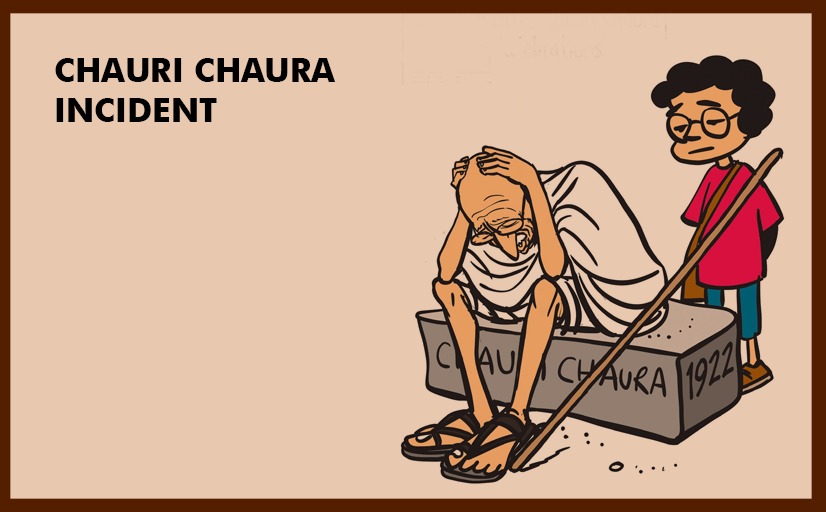
Chauri Chaura Incident
- The town of Chauri Chaura is located in Uttar Pradesh's Gorakhpur district.
Chauri Chaura Incident

- The town of Chauri Chaura is located in Uttar Pradesh's Gorakhpur district.
- On February 4, 1922, a large gathering of protesters engaged in the Non-Cooperation movement clashed with police, who then opened fire. This incident is known as the Chauri Chaura incident and took place in the Chauri Chaura neighborhood of the Gorakhpur district of the United Province (modern Uttar Pradesh) in British India. The police station's occupants were all killed when protesters attacked and set fire to it as retaliation.
- 23 police officers and three civilians were killed in the incident. As a direct result of this incident, Mahatma Gandhi, who vehemently opposed violence, put an end to the Non-Cooperation Movement on a national level on February 12, 1922.
The incident's history.
- Gandhiji started the Non-Cooperation Movement against the government on August 1st, 1920.
- It involved "refusing to assist a ruler who misrules," which included using swadeshi and boycotting foreign goods, particularly machine-made cloth, as well as legal, educational, and administrative institutions.
- Volunteers from the Congress and the Khilafat Movement were organized into a national volunteer corps during the winter of 1921–1922.
- In an effort to preserve the Ottoman caliph as a sign of harmony among the Muslim community in India during the British raj, the Khilafat Movement emerged as a pan-Islamic force in 1919.
- The movement had the backing of the Congress, and Mahatma Gandhi tried to link it up with the Non-Cooperation Movement.
- Chauri Chaura Incident:
- Volunteers gathered on February 4 in the town, and after the meeting, they marched to the neighborhood police station and set up a picket at the Mundera bazaar.
- Several people were killed and numerous volunteers were injured when the police opened fire into the crowd.
- The crowd then went on to burn down the police station in retaliation.
- There was a lot of police property destroyed, including weapons, and some of the policemen who attempted to flee were caught and brutally killed.
- Britain's response:
- The British Raj aggressively pursued the defendant.
- Only 19 of the 225 defendants were ultimately found guilty, and a sessions court swiftly sentenced 172 of them to death.
- Mahatma Gandhi's reaction
- The killing of the policemen was a crime, which he denounced. In order to show "genuine sympathy" and seek restitution, the volunteer organizations in the nearby villages were disbanded. Instead, the Chauri Chaura Support Fund was established.
- Gandhi made the decision to put an end to the Non-Cooperation Movement because he believed it had been tainted by abhorrent violence.
- The satyagraha (movement) was formally suspended on February 12, 1922, as a result of his manipulation of the Congress Working Committee.
- For his part, Gandhi defended himself by citing his unwavering belief in non-violence.
- Reaction of Other National Leaders:
- When Gandhiji decided to end the fight after the civil resistance had solidified its position in the freedom movement, Jawaharlal Nehru and other leaders of the non-cooperation movement were shocked.
- Motilal Nehru and CR Das, among others, expressed their shock at Gandhi's choice and decided to found the Swaraj Party.
Chauri Chaura Incident Events
|
Facts |
Explanation |
|
Reason for incident |
A manifesto outlining Gandhi's nonviolent noncooperation strategy preceded the Chauri-Chaura event. |
|
Location |
It is located in the Gorakhpur District of the Indian state of Uttar Pradesh (UP). |
|
Political or social impact |
172 of the 225 inmates were given the death penalty; however, 19 of them were hanged to death, and the other defendants were transported. |
|
How is Bhagwan Ahir related to the Chauri Chaura incident? |
His assault by British police, which sparked outrage on social media and the Chauri-Chaura incident, was committed by a retired army officer from Gorakhpur, Uttar Pradesh. |
|
Major event related to the Chauri-Chaura incident |
In February 1922, the Non-Cooperation movement was put an end to. |
What did the suspension of the movement result in?
- Many of the younger Indian nationalists came to the depressing realization that India would not be able to end colonial rule through non-violence as a result of the suspension of the Non-Cooperation Movement.
- Some of India's most prominent revolutionaries, such as Jogesh Chatterjee, Ramprasad Bismil, Sachin Sanyal, Ashfaqulla Khan, Jatin Das, Bhagat Singh, Bhagwati Charan Vohra, Masterda Surya Sen, and many others, emerged from the ranks of these impatient patriots.
- A rift between Congress and the leaders of the Muslim community was also caused by the abrupt end of the Non-Cooperation Movement, which demoralized the Khilafat movement.
